Heating is one of the most critical yet often overlooked aspects of industrial and energy-sector operations. From construction projects to oilfield sites, maintaining adequate heat keeps workers safe, prevents equipment failures, and ensures projects stay on schedule. But heating is also one of the most significant hidden costs of any project—burning diesel, generating emissions, and consuming labor hours.
For decades, traditional heaters have been the default option. However, as costs rise and sustainability becomes a priority, efficiency matters more than ever. This is where the Jet Heat and Micro Jet systems from REIC Specialty have changed the game. These heaters combine cutting-edge technology, superior efficiency, and robust support services to deliver more heat per gallon of fuel, lower total costs, and significantly reduce emissions compared to conventional heaters.
This article provides a detailed cost comparison between Jet Heat/Micro Jet and traditional heaters, focusing on fuel usage, operating costs, emissions, and long-term return on investment.
Industrial heating is more than just a background process; it’s an operational necessity. On a project site, heating impacts:
With fuel costs fluctuating and environmental regulations tightening, companies can no longer afford to rely on inefficient heating solutions. Every gallon of diesel burned matters—financially and environmentally.
Traditional heaters often struggle here: oversized designs, high fuel use, and inefficient heat conversion make them costly and unsustainable. Jet Heat and Micro Jet are purpose-built to address these shortcomings head-on.
The cost analysis in this article is standardized to ensure an apples-to-apples comparison. All calculations are based on:
This framework allows us to compare REIC’s Jet Heat and Micro Jet directly against traditional heaters regarding cost and output.
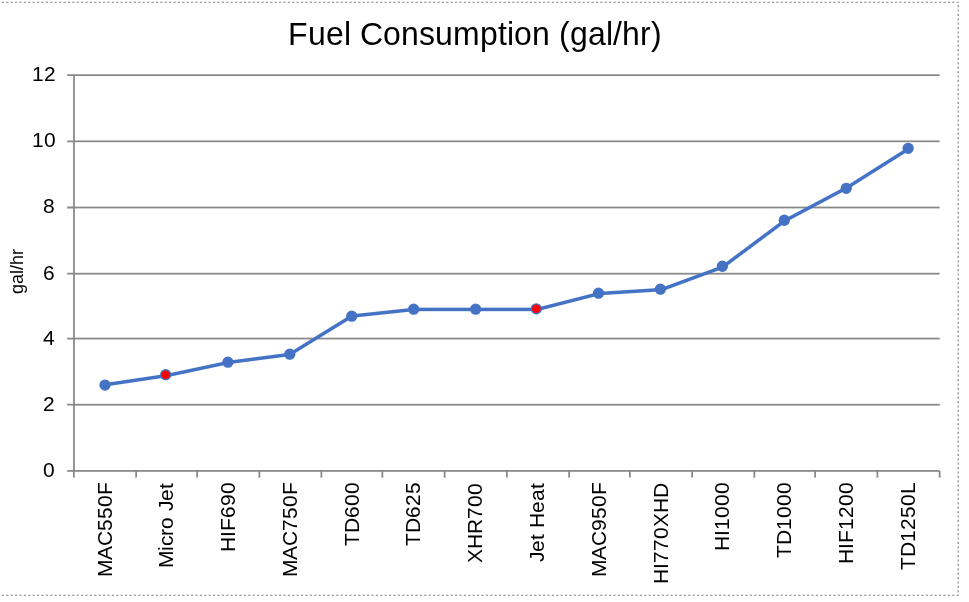
Graph: The chart plots fuel consumption in gallons per hour for a range of heaters.
On the low-consumption end, one competitor model consumes approximately 2.5 gallons/hour. Just above that, the Micro Jet consumes around 3 gallons/hour. About five models cluster between Micro Jet and Jet Heat, showing moderate consumption in the 3–5 gallons/hour range. Jet Heat sits at about 5 gallons/hour. Beyond Jet Heat, six additional competitor models consume more, with fuel use steadily rising toward the top of the chart at 10 gallons/hour.
Interpretation:
Micro Jet and Jet Heat are among the most fuel-efficient heaters in the comparison. Micro Jet sits just above the lowest-consuming unit, making it one of the best performers for projects where minimizing fuel use is critical. Jet Heat uses slightly more fuel, striking a balance between efficiency and performance.
Traditional heaters typically consume 3–10 gallons per hour, with the least efficient model consuming nearly 10 gallons—over three times Micro Jet’s demand. For projects, this means higher fuel costs, more refueling, added logistics, and greater emissions—challenges Jet Heat and Micro Jet help avoid.
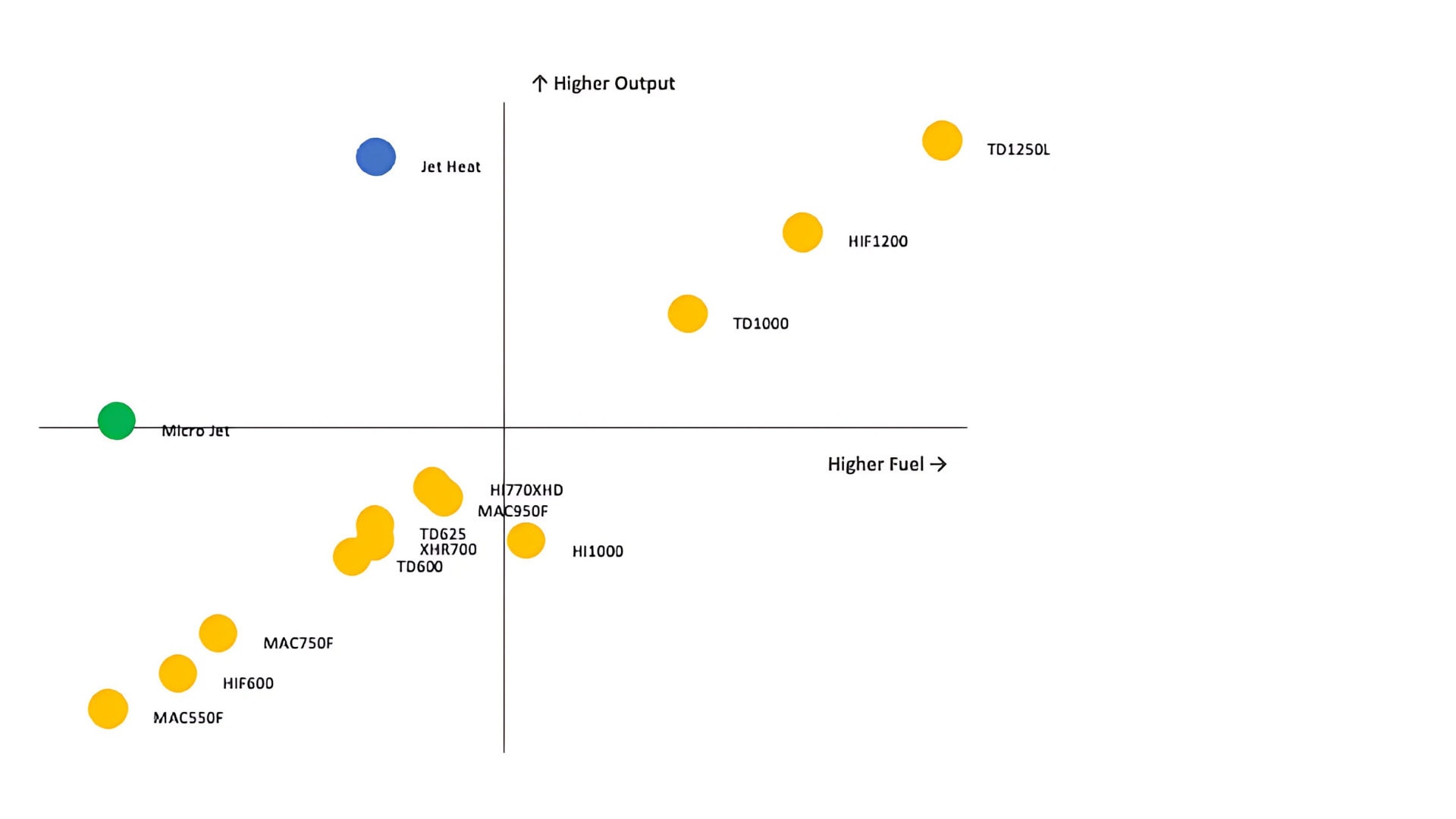
Graph: The chart plots fuel use on the horizontal axis against heat output on the vertical axis.
Jet Heat is plotted in the top-left quadrant, requiring less fuel while providing a high output. Micro Jet uses less fuel while providing a moderate heat output. Traditional heaters cluster in the bottom-left (requiring less fuel for lower output) and the top-right (requiring more fuel for high output).
Interpretation:
Jet Heat and Micro Jet achieve superior performance ratios by delivering strong heat output with comparatively low fuel use. Jet Heat sits in the top-left quadrant, the optimal zone of high output with low fuel use. Micro Jet delivers slightly lower output but remains highly efficient. This efficiency means fewer units are needed to meet project requirements, which reduces site congestion, minimizes ducting and setup complexity, and lowers ongoing fuel logistics.
In contrast, traditional heaters cluster in less efficient zones, requiring more units and more fuel to deliver modest results—driving up costs and operational burdens.
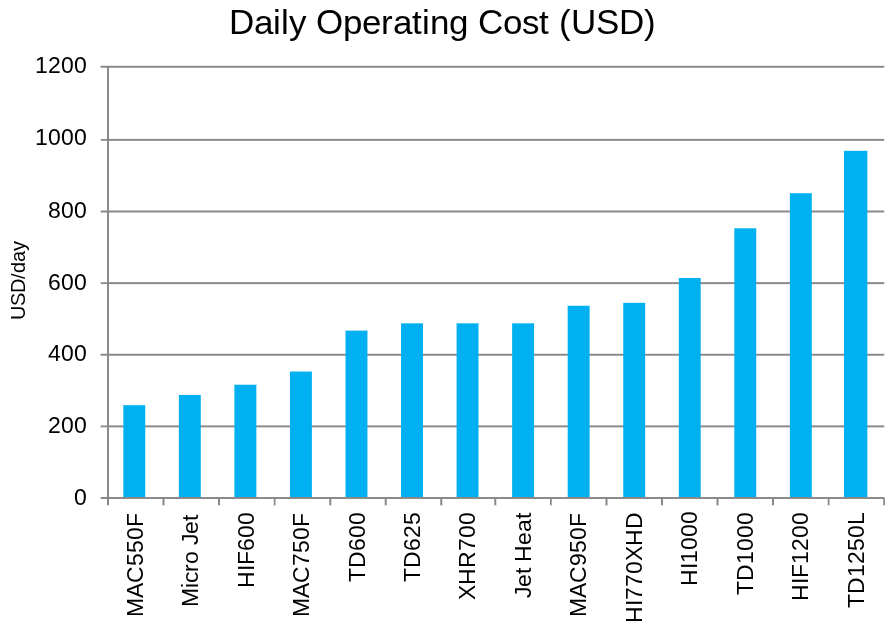
Graph: The graph shows the daily operating cost, measured in USD per day.
Micro Jet costs just under $300/day, compared to the lowest model, which costs about $230/day. Jet Heat costs around $500/day. Competitor heaters rise steadily, with one model nearing $1,000/day.
Interpretation:
Jet Heat and Micro Jet sit at the lower end of daily operating costs while still delivering consistent, reliable performance. Traditional heaters, by comparison, consume substantially more fuel to produce equivalent heat, which drives their daily costs steadily upward.
By converting a greater share of each gallon into usable heat rather than wasted exhaust, Jet Heat and Micro Jet provide a clear efficiency advantage that translates directly into lower daily operating expenses.
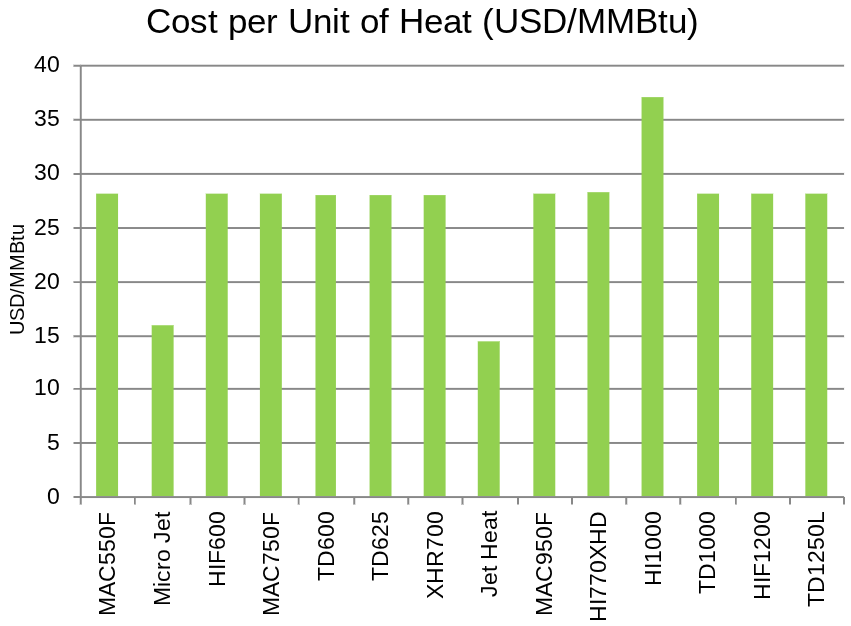
Graph: The chart compares cost per unit of heat, measured in USD per MMBtu.
USD/MMBtu provides a standardized way to compare heaters of different sizes and outputs. It measures how much it costs to produce a fixed amount of heat, highlighting true efficiency rather than just daily rental rates or raw fuel consumption.
Jet Heat sits just under $15/MMBtu, and Micro Jet slightly above $15/MMBtu. Most traditional heaters cluster around $28/MMBtu, with one outlier (the H1000) at about $37/MMBtu.
Interpretation:
Jet Heat and Micro Jet are far more cost-efficient than traditional alternatives when normalized for actual heat output. They deliver nearly the same amount of usable heat at almost half the cost of most competitor models. The outlier, H1000, demonstrates how quickly inefficiency compounds into cost overruns.
This gap translates into substantial savings for projects running continuously over weeks or months—lower fuel bills, fewer refueling events, and reduced logistical overhead. In practical terms, choosing Jet Heat or Micro Jet means operators can achieve the same heating performance with fewer dollars spent per unit of energy, freeing up budget and resources for other critical project needs.
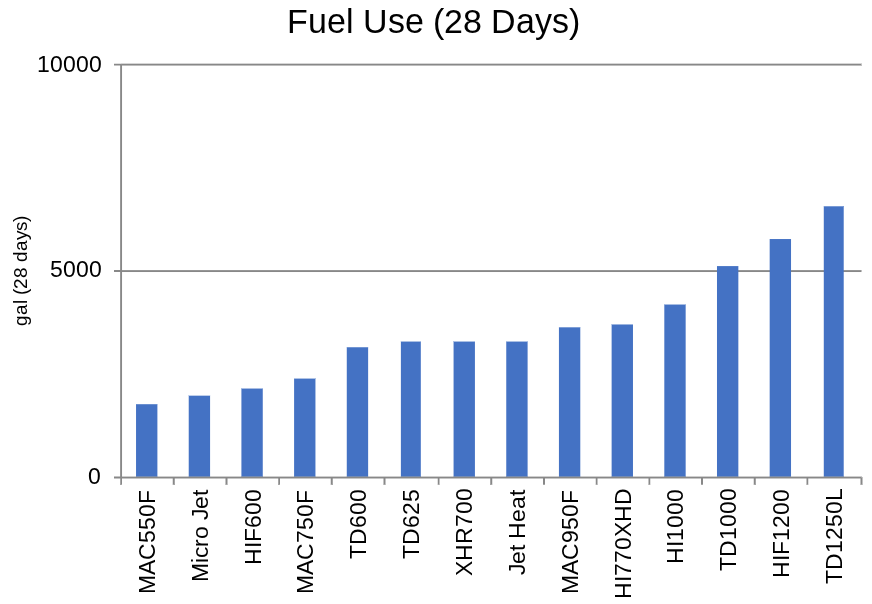
Graph: The chart illustrates total fuel use over a 28-day cycle, measured in gallons per 28 days.
Micro Jet uses approximately 1,875 gallons over 28 days, which is closely matched by MAC550F. Jet Heat is positioned slightly higher at about 3,125 gallons/28 days.
In contrast, competitor models show steadily rising consumption, with most falling well above Jet Heat. The TD1250L reaches the top of the chart at roughly 6,250 gallons/28 days.
Interpretation:
Micro Jet and Jet Heat stand out for their efficiency. They consume far less fuel than traditional heaters over the same 28-day cycle. They also sit well below the heavy fuel demands of competitor models, some exceeding 5,000 gallons.
This difference translates into lower fuel costs, fewer delivery and handling requirements, and reduced risk of spills or logistical delays for operators. Over a month-long project, these savings compound into measurable reductions in operating expenses and environmental impact, making Jet Heat and Micro Jet more economical and reliable than traditional alternatives.

Graph: The graph shows total operating cost over a 28-day cycle, measured in USD.
The lowest-cost model is around $7,500 over a 28-day cycle, followed closely by Micro Jet at approximately $8,000. Jet Heat is positioned at about $13,000, while the most expensive competitor reaches nearly $28,000 over a 28-day cycle.
Interpretation:
Over a 28-day cycle, Micro Jet ranks among the lowest-cost heaters, positioned just above the least expensive competitor. Jet Heat, while having a higher cost over a 28-day cycle, delivers substantially greater heat output, making it highly cost-effective when measured per unit of energy delivered. In contrast, traditional heaters escalate sharply in cost, with some models more than doubling Jet Heat’s expense and exceeding three times that of Micro Jet.
For project budgets, this means Jet Heat and Micro Jet not only reduce direct fuel spend but also lower associated costs tied to refueling, logistics, and downtime. These results demonstrate their advantage in keeping overall operating expenses under control compared to traditional heaters.
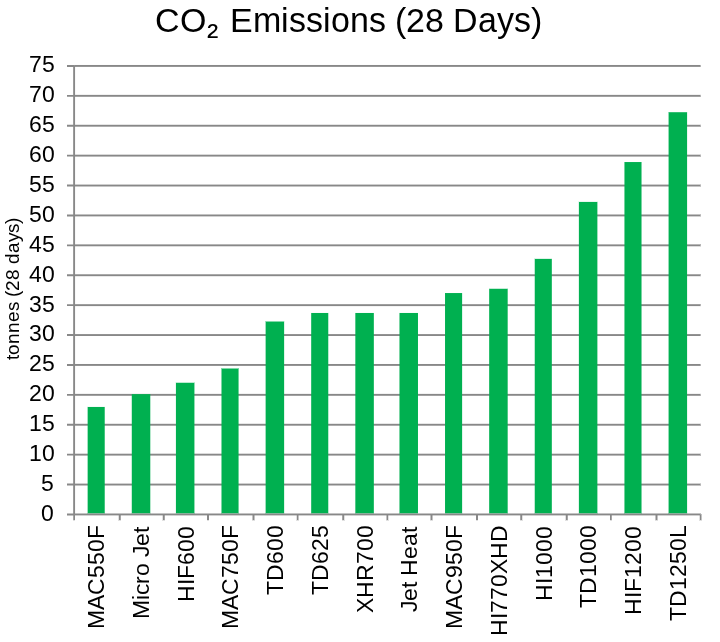
Graph: The chart shows CO₂ emissions over a 28-day cycle, measured in tonnes.
The lowest-emitting heater produces about 18 tonnes, followed by the Micro Jet at 20 tonnes. Jet Heat emits around 34 tonnes, while the highest competitor reaches approximately 67 tonnes over a 28-day cycle.
Interpretation:
Micro Jet and the MAC550F record the lowest CO₂ emissions. Jet Heat produces higher CO₂ emissions while delivering higher heat output. In comparison, traditional heaters produce far greater emissions, driven by higher fuel use. These differences reflect the direct link between fuel consumption and emissions: for every gallon of diesel saved, Jet Heat and Micro Jet prevent 10.19 kg of CO₂ from entering the atmosphere.
For operators, this not only lowers environmental impact but also supports compliance with emissions targets and ESG commitments.
The financial impact of choosing Jet Heat or Micro Jet extends well beyond the initial 28-day rental period. Their efficiency not only lowers immediate fuel bills but also reduces the many indirect costs associated with traditional heaters.
Put simply, Jet Heat and Micro Jet deliver superior return on investment (ROI) across the entire lifecycle of a project—outperforming traditional heaters not only in direct operating costs, but also in efficiency, risk reduction, and long-term value creation.
REIC’s Jet Heat and Micro Jet heaters are engineered not only for efficiency but also to address the practical and safety challenges of running complex project sites. They combine high-performance heating with design features that simplify operations, reduce risks, and provide reliable oversight.
These advantages reduce downtime, streamline operations, improve compliance, and protect against costly risks—benefits that traditional heaters cannot match.
Companies today face mounting pressure to demonstrate ESG (Environmental, Social, and Governance) responsibility. ESG is a framework
that evaluates how businesses manage their environmental impact, social responsibilities, and governance practices. Though often overlooked, heating can represent a significant share of project fuel use and emissions, making it an essential part of this equation.
By choosing Jet Heat and Micro Jet, companies can reduce measurable emissions of CO₂, NOₓ, and SOₓ, cut down on unnecessary diesel trucking and logistics, and provide tangible evidence of sustainability improvements to stakeholders. Beyond lowering operating costs, these advantages strengthen the Environmental component of ESG reporting, enhance brand reputation, and position companies as leaders in sustainable operations.
The data is conclusive: Jet Heat and Micro Jet consistently outperform traditional heaters across every metric that matters.
In an era where costs and sustainability are scrutinized, REIC Specialty delivers the best of both worlds: lower operating costs and a smaller environmental footprint, backed by reliable, operator-friendly technology.
Choosing Jet Heat or Micro Jet is more than a rental decision—it’s a strategic investment that improves performance, reduces risk, enhances safety, and aligns operations with environmental goals.
Ready to cut costs, lower emissions, and simplify operations on your next project?
Contact REIC Specialty today to discover how Jet Heat and Micro Jet can transform your site heating strategy.
Don’t settle for outdated, inefficient heaters. Choose REIC—and experience heating done smarter.